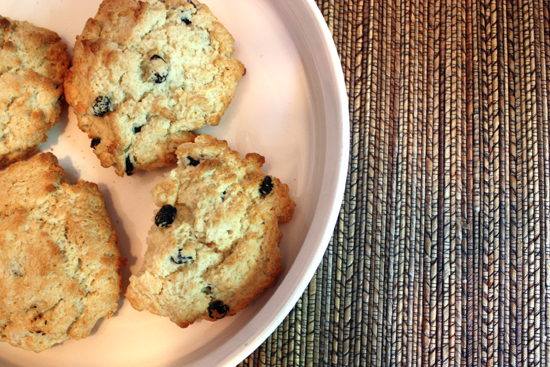I have always loved buying things from estate sales. I usually buy small things: costume jewelry, cookbooks, baking pans. Inanimate objects bring some of their history with them and I find them all the more interesting for it. I wonder what parties my bright bead necklaces have seen… were they dangling around a taught neck during a first kiss? What flavors of muffins most often popped out of my muffin tin before it came to live with me? Was the author of those Joy of Cooking margin notes left handed?
The same romance draws me to recipes that have been passed down, even if they come from people I have never met. This scone recipe is one of them. My mom has been making this recipe she received from a woman named Pam whose mother Helen used to serve scones with tea. I was so taken by the scones my mother asked her if I could share the recipe with all of you. Pam agreed and offered this endearing information about her mother who recently passed away:
A few words about my mom, Helen – She loved gathering people together and serving wonderful food. As a New Englander, she grew up with the tradition of drinking tea, and created little tea parties for my sisters and me with our child-size Blue Willow tea set. She made Cambric Tea for us, which is just tea with sugar and lots of milk, so that the tea looks the color of unbleached linen. Cambric is a word for very fine linen. Tea was always served informally when our aunts came to visit, or when we visited them. Someone would “throw the kettle on”, the most basic form of hospitality. Mum made many kinds of beautiful tea sandwiches and sweets for more formal occasions, and took delight in presenting prettily arranged trays of tea dainties and placing fresh flowers on the table. She was always on the alert for new recipes, and enjoyed the surge of interest in tea and related foods in recent years.
Thank you for sharing Pam. And Helen, wherever you are, we raise our tea cups to you! Your recipe lives on…
Helen’s Delectable Currant Scones
Serve with Devonshire Cream and an assortment of preserves; these are also excellent with no adornment at all.
1/4 cup dried currants
2 cups all-purpose flour
1 Tbsp baking powder
1/2 cup unsalted butter
1 Tbsp brandy
6 Tbsp granulated sugar
1/4 tsp salt
1/2 cup buttermilk plus 2 tsp for brushing tops of scones
grated rind of one orange
Mix currants, brandy and peel in small microwave-safe bowl and micro at full power 15-20 seconds until just warm.
In medium bowl, blend 2 cups flour, 6 Tbsp sugar, baking powder and salt. With a pastry blender, blend in the butter until no lumps larger than 1/4″ remain. The mixture will look like coarse crumbs. Strir int he currant mixture.
Add 1/2 cup buttermilk, stirring just enough to evenly moisten the dough. Gather dough into a ball, sprinkling with additional drops of buttermilk if necessary. Knead lightly just until hte dough holds together.
Flatten dough to 1/2″ thickness. You may cut into rounds or form a circle and bake in a round scored in wedges. Transfer the scones to a buttered baking sheet, leaving space between them. Brush tops of scones with buttermilk. Sprinkle tops with granulated sugar if you like a sparkling crunch on top.
Bake in 400 degree oven until golden brown (20-25 minutes). Watch smaller cut shapes so you do not overbake. Transfer to a rack to cool slightly. Serve warm.
PRINT RECIPE
